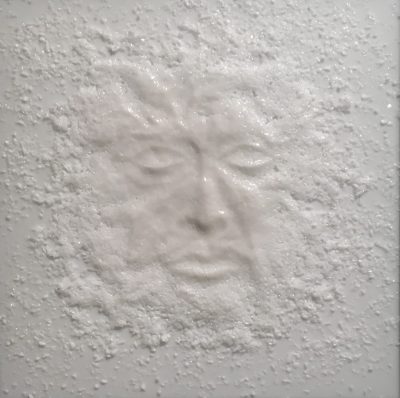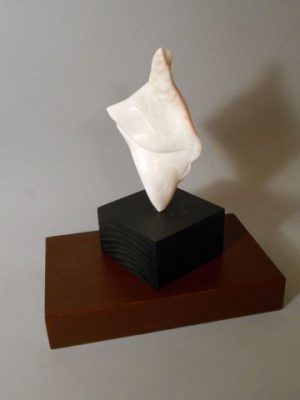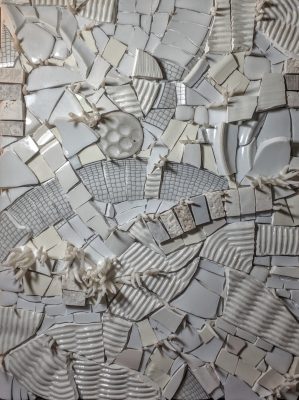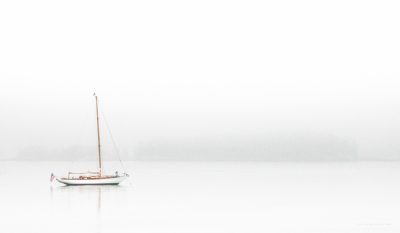This article was originally published in The Town Courier.
Jaree Donnelly wanted to do something a little different for the new year. In December, the Arts Barn’s walls were adorned with the “beautiful and boldly colored” artwork of the “Bright Concepts” exhibit. Her call for artists for the first show of 2017, in contrast, specified submissions of works that are 90 to 95 percent white or colorless.
“Winter White,” the staff-juried result, “is a nice counterpoint to the intensity” of the previous show, Donnelly observed. “There’s softness, simplicity. It’s more about texture, shape and subtleties.” The exhibit consists of 27 works of sculpture, glass, oil, acrylic, clay, photography and mixed media by 16 different artists. Donnelly, who curated the exhibit but has moved on to serve as the Arts Barn’s arts education coordinator, is pleased with these high-caliber representations of nature, the human form and everyday objects.

Glass artist Tony Glander, in residence at the Arts Barn since its opening 14 years ago, created “Old Man Winter” for the show. “Two-dimensional work is a little bit of a departure for me,” he noted. “It really gives me a chance to think outside the regular pieces I do for commission work.”
Glander had tried the technique only once before–“Using glass grit, basically powdered glass, I fire it in the kiln until it barely melts together. In this case, I had to make a mold of a mold to create the face. I fired a piece of glass on a ceramic mold of the face. In turn, I used the impression of the face in the glass to cast the face you see on the wall.” The resulting face, he added, “is literally made of very small pieces of glass melted at just the right temperature to hold them together without melting the mold. The face casting was fired once more onto the base glass with a fine layer of extra frit.”
For Jack Donnelly, another Arts Barn resident artist (and Jaree’s husband), the call for entries provided impetus to replicate an experience of “incredible natural splendor.” His painting, “Snow Blind” is “based on some wonderful memories of being up in the Colorado mountains on a clear sunny day without a cloud in the sky. The combination of the unfiltered high altitude sunlight with the snow was very intense.”
All Donnelly’s art–which most often is three-dimensional metal sculpture–“pulls from observing the patterns and cycles of the natural world,” he said. Painting, which “requires a lighter touch” is “a complete change of scenery, medium wise.” In his paintings, he typically “builds a sculptural/textural dimension into the surface. This time, I used acrylic medium applied with a tool made for spreading tile grout. In the extreme foreground, I was able to become Old Man Winter for a spell and create a snow drift in the lower right corner.” His wife noted that Jack has spent more than a few evenings in their shared studio adding to the snow drift.

Sheryl Massaro, a painter, photographer, ceramicist and poet who lived in the Kentlands for 20 years, took her “first official art class in 2004 from resident artist Howard Cohen” at the “dear to my heart” Arts Barn. Her oil painting, “Albino Bison in a Snowstorm,” said Jaree Donnelly, has elicited a great deal of positive comment from visitors. The painting represents, Massaro said, “my endeavor to tap into and convey life’s undertows. These are the unspoken things that ultimately bring close and bind artists and…viewers. They are in the lives of agricultural fields and barns, …in bodies of water and their islands and shores; in the bodies and eyes of animals, wild and domestic; in the human form; in our architecture; and, especially, in the light and shading that enables each of these to be hidden, noticed or noticeably hidden.”
Among sculptor Richardene Forrest-Thweatt’s three pieces in the show is “Frozen,” carved from mica, “a glass-like stone (that) is quite unstable and flakes or breaks in one direction,” thus “requiring a process of fine filing to develop the sculpted form.” She used “the direct carving method with hammer and chisel” to create her other two pieces, “Churinga” and “Contemplation,” both in alabaster. Alabaster and soapstone, she said, are her primary media “because of the rocks’ strength, variety of colors, veining and raw beauty.”
“Much of my development process is intuitive, working to maintain a sense of respect for the material and harmony for the interplay of light and space,” Thweatt observed. “This process and technique lets me develop the raw material to create soft, rounded, sensual shapes that express feelings and movement or to release the form within.”

Jennifer Pizzillo collects materials for her mosaics during her travels as well as at “estate sales, discount shops and thrift stores in search of mismatched ceramic and glassware. I even pick up scavenged items and nature elements when they are interesting.” Her art is based on her “love (for) the challenge of cobbling together many different types of materials and finding ways to marry them into lovely textures and swaths of color.”
Like most of her recent work, her piece, “the near absence of all color,” is “direct set pique assiette (French for broken dish) mosaic, which basically means I don’t use grout…(which) changes how you compose, and you don’t have those grout lines to help define shapes and movement. I like to fit everything together as tightly as possible so that none of the mastic or substrate is visible.”
Sculptor Homer Yost always works from life and in wet clay. He created “Shape of My Heart’ with a live model he uses in both his studio and his classes. Music by Sting was in the background while they worked, and “Shape of My Heart’ was a mutual favorite. “This seemed to be an appropriate title for the sculpture, also considering the composition and mood of the pose,” he said. The piece was molded and then cast in white Vatican stone, “a very hard material consisting of hydrocal (strong plaster) and marble chips,” then sealed and waxed.

After getting “seriously burned out” from practicing law, Marleen Van den Neste turned to photography about eight years ago. Fog dominates two of her four pieces in “Winter White.” “Fog–to me–has something mysterious, it’s soothing and peaceful and I feel like I’m in my own world,” she said, acknowledging that “the editing process when dealing with fog is hard.” “Fog and Tree,” she noted, “has special nostalgic value because it’s a tree I gave my mother when she turned 50. It stands at the border of a lake in my mother’s yard (in the Netherlands) and I cannot tell you how much time I’ve spent just sitting there and admiring it in all different weather circumstances.” “Fog and Boat” was taken last year at Boothbay Harbor in Maine. “You can imagine how absolutely in awe I was when there was this same dense fog over the harbor,” she recalled.
The City of Gaithersburg’s Arts on the Green presents “Winter White,” featuring work by Richardene Forrest-Thweatt, Michael Kuchinsky, Linda Orenstein, Elizabeth Steel, Mary Weiss-Waldron, Fran Abrams, Matthew Baker, Tony Glander, Judy Gross, Sheryl Massaro, Jack Donnelly, Jennifer Pizzillo, Homer Yost, Richard Weiblinger, Yolanda Prinsloo and Marleen Van den Neste, through Feb. 27 at the Arts Barn, 311 Kent Square Road. Hours are weekdays, 10 a.m. to 5 p.m., and Saturday, 1:30 to 5 p.m. Call 301-258-6394. View this event on CultureSpotMC here.